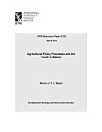Mitigating poverty and undernutrition through social protection: A simulation analysis of the COVID-19 pandemic in Bangladesh and Myanmar
Ecker, Olivier · Alderman, Harold · Comstock, Andrew R. · Headey, Derek D. · Mahrt, Kristi · Pradesha, Angga
Feb 2023 · IFPRI Discussion Paper Buku 2170 · Intl Food Policy Res Inst
eBook
51
Halaman
family_home
Memenuhi syarat
info
reportRating dan ulasan tidak diverifikasi Pelajari Lebih Lanjut
Tentang eBook ini
The COVID-19 pandemic resulted in severe income losses, but little is known about its impacts on diets and nutritional adequacy, or the effectiveness of social protection interventions in mitigating dietary and nutritional impacts. We first assess the likely impacts of COVID-19 shocks in Bangladesh and Myanmar on poverty and food and nutrient consumption gaps. We then analyze the estimated mitigating effects of five hypothetical social protection interventions of a typical monetary value: (1) cash transfers; (2) in-kind transfers of common rice; (3) in-kind transfers of fortified rice enriched with multiple essential micronutrients; (4) vouchers for a diversified basket of rice and non-staple foods; and (5) food vouchers with fortified rice instead of common rice. The simulation results suggest modest effectiveness of the cash transfers for mitigating poverty increases and little effectiveness of all five transfers for preventing increasing food and nutrient consumption gaps among the poorest 40%. Rice fortification is, however, effective at closing key micronutrient consumption gaps and could be a suitable policy instrument for averting ‘hidden hunger’ during economic crises.
Beri rating eBook ini
Sampaikan pendapat Anda.
Informasi bacaan
Smartphone dan tablet
Instal aplikasi Google Play Buku untuk Android dan iPad/iPhone. Aplikasi akan disinkronkan secara otomatis dengan akun Anda dan dapat diakses secara online maupun offline di mana saja.
Laptop dan komputer
Anda dapat mendengarkan buku audio yang dibeli di Google Play menggunakan browser web komputer.
eReader dan perangkat lainnya
Untuk membaca di perangkat e-ink seperti Kobo eReaders, Anda perlu mendownload file dan mentransfernya ke perangkat Anda. Ikuti petunjuk Pusat bantuan yang mendetail untuk mentransfer file ke eReaders yang didukung.










